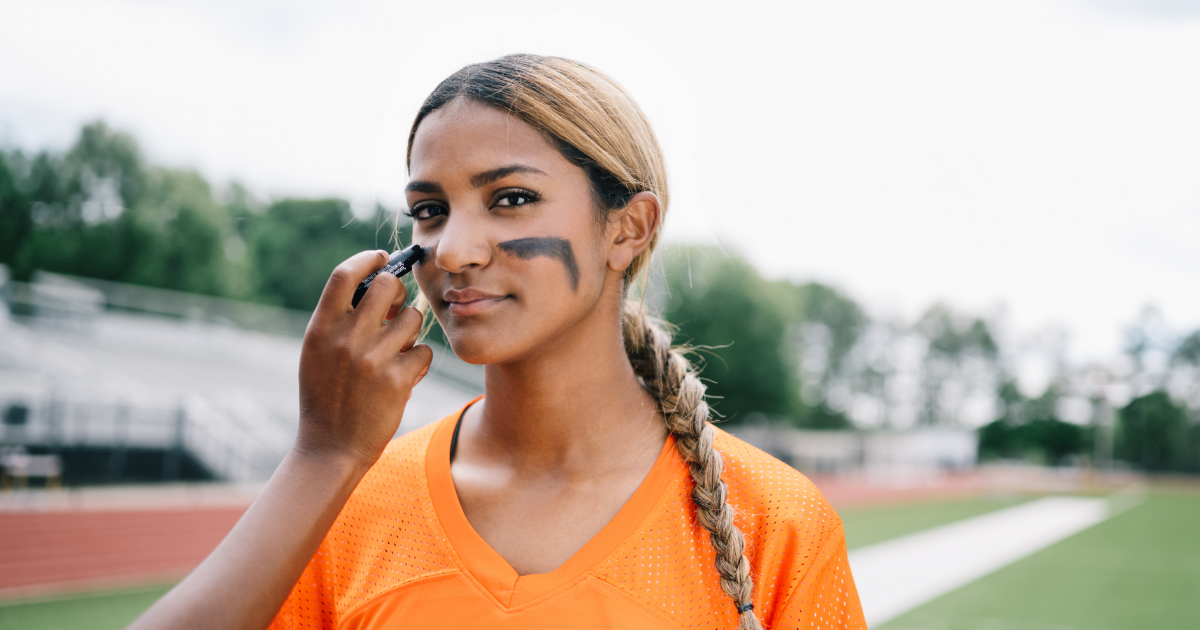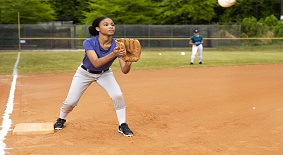What Is the Female Athlete Triad?
Updated 9/6/22
When young female athletes over train and undereat, they may lack the energy their bodies need not only for athletic performance, but for healthy development. Low energy availability can lead to amenorrhea or missed periods and low bone density—these three conditions are known as the female athlete triad.
It’s uplifting seeing your daughter dedicate herself to a sport she loves. But too many hours in the gym or in the pool can lead to problems if she’s not fueling her body appropriately. “Athletes underestimate how many calories they should be consuming,” says Children’s sports medicine primary care physician Tatiana Patsimas, MD.
When athletes are training rigorously, but not eating enough, they get off balance nutritionally. The result: low energy availability. This is one key component of the female athlete triad.

3 components of the female athlete triad
The female athlete triad is a medical condition characterized by a combination of three symptoms:
“Low energy availability leads to the other two legs of the triad, as well as myriad other physiological issues that are less apparent,” says Dr. Patsimas. “Each of the symptoms live on a spectrum—they may be mild or more severe. An athlete can be anywhere on the spectrum with these three issues and still be diagnosed with the triad.”
4 overlooked signs of the female athlete triad you need to know
Parents and coaches should be on the lookout for these signs of the female athlete triad to help prevent potentially serious and long-term health issues in young female athletes.
1. Poor performance
“Without enough energy availability, athletes will have less energy for important bodily functions as well as athletic performance. Similar to having a phone on ‘low battery mode,’ the athlete can still function, but to a lower level,” explains Dr. Patsimas. Your daughter may complain of feeling like she’s “hitting a wall” no matter how hard she trains.
2. Multiple stress fractures
Low energy availability affects musculoskeletal health. Your daughter may experience stress injuries or overuse injuries (an injury to the bones, muscles, tendons or joints that occurs because of repetitive stress or movements), which can keep her out of competition for extended periods of time.
3. Preoccupation with food, body image or weight loss
Your daughter may exhibit signs of disordered eating, particularly if she is involved in a sport that emphasizes a lean physique.
4. Low self-esteem
If your young athlete is training harder, but her performance is lacking, she may begin to doubt her abilities. Injuries that keep her out of play may also make her feel isolated from her peers and activities, which also can impact her self-esteem.
If you recognize any of the signs of the female athlete triad in your daughter—whether she’s a recreational athlete or involved in a competitive league—it’s important to talk to her primary care provider. You may also consider scheduling an appointment with one of Children’s sports primary care physicians who are specially trained to care for young athletes.
A doctor can help you identify these signs of the female athlete triad and address the key symptoms explained below to help your daughter participate in athletics without compromising her health.
It can be tricky to find the right balance when it comes to calorie consumption. Young athletes may not realize just how much fuel their body needs to function during high-intensity training and competition. Sometimes it’s purely a lack of awareness that leads female athletes to eat too little.
How to help your athlete get the fuel she needs
If you and your daughter are uncertain what types of foods and how many calories are appropriate for her level of activity, talk to your pediatrician or a sports medicine primary care provider. They can refer you to a dietitian who can help design a meal plan that provides your daughter enough fuel to keep her energy levels up, which can help avoid the complications associated with the female athlete triad.
Signs your athlete is struggling with disordered eating
It’s important to keep in mind that not eating enough can also be a sign of disordered eating (extreme and inconsistent eating patterns). “Generally, disordered eating is the practice of unsafe or unhealthy habits in order to lose weight or to promote ‘healthfulness.’ More serious eating disorders like bulimia nervosa and anorexia nervosa are psychiatric diagnoses that can be life threatening,” says Dr. Patsimas.
Some signs that your daughter may have an unhealthy relationship with food include:
- Fluctuating weight
- Following diet trends
- Using diet pills or supplements
- Under or overeating
- Intense focus on appearance
Disordered eating and eating disorders are obviously not limited to female athletes. Anyone, male or female, can struggle with these unhealthy eating habits. If you notice any of the signs above in your child, talk to your pediatrician. A consultation with a mental health specialist may be recommended.
One key sign of low energy availability in female athletes is menstrual dysfunction. This includes irregular cycles—missing periods during the sports season and getting them back in the off-season. Or it may mean a complete lack of menstruation.
What is amenorrhea?
The absence of menstrual periods is called amenorrhea. “Amenorrhea can be due to a variety of reasons, such as endocrine, structural or other disorders. Low energy availability or the female triad is just one cause,” says Dr. Patsimas.
However, menstrual dysfunction is very common in female athletes, particularly in sports that require high endurance or high energy output like running and gymnastics. Parents should be concerned and talk to their child’s pediatrician if their daughter:
- Has not had her first period by age 15
- Misses three periods in a row
- Often has periods that are spaced more than five weeks apart
Why is amenorrhea a concern?
Amenorrhea or menstrual irregularity that is left untreated can have lasting effects on your daughter’s health, including delayed puberty and loss of bone density.
Talk to your daughter about the importance of a regular menstrual cycle. Encourage her to keep track of her periods and to notify you or her doctor of any changes.
Bone mineral density, or the amount of minerals like calcium in the bones, is a key indicator of bone health. Typically, we reach optimum bone density around age 18, so bones are still growing and changing in younger athletes.
When a female athlete has low energy availability, hormone levels shift and negatively affect bone mineral density. Low bone mineral density is known as osteopenia. It’s measured on a spectrum. At its lowest, decreased bone mineral density can lead to osteoporosis.
“Osteoporosis in a child or adolescent is defined by a low bone mineral density, as well as a significant fracture history. This is a severe outcome of the female athlete triad,” says Dr. Patsimas.
How to improve bone mineral density
If your daughter experiences multiple stress fractures, it’s important to have her evaluated for low bone mineral density. Identifying this condition early can help limit bone loss and future problems. Your child’s doctor may recommend the following to help restore some bone mass:
- Sufficient caloric intake to ensure proper energy levels
- Resuming healthy menstruation, which may require a period of inactivity
- Incorporating weight-bearing exercises into training if lacking
“It’s important to take steps to prevent further bone loss and slowly recover bone mineral density,” says Dr. Patsimas.
The signs of the female athlete triad can range from subtle to more severe. If you have any suspicion that your daughter may be experiencing side effects of low energy availability, a Children’s sports medicine physician can help.
Our team is specially trained to care for youth and teen athletes, so they can identify problems that might go unnoticed by a doctor who only treats adults, provide care tailored to growing bodies and offer insight to help get kids back to the activities they love.

Whether your teen athlete plays one sport or 10, where you take them matters.
The highly qualified and experienced pediatric sports medicine specialists at Children’s are dedicated exclusively to youth and teen athletes. Each member of our team is focused on getting kids back to doing the things they love most in the safest ways possible.
Find a SpecialistKeeping Young Athletes Healthy
Tatiana Patsimas, MD, a Pediatric Sports Medicine Primary Care Physician in the Sports Medicine Program at Children’s Healthcare of Atlanta, specializes in the treatment of teen athletes. During her fellowship training, Dr. Patsimas served as a team physician for the women's lacrosse, soccer, basketball and volleyball programs at Denver University. As a former ballet, jazz and lyrical dancer, Dr. Patsimas’s clinical interests include dance, cheerleading and gymnastics injuries as well as concussion management.
This content is general information and is not specific medical advice. Always consult with a doctor or healthcare provider if you have any questions or concerns about the health of a child. In case of an urgent concern or emergency, call 911 or go to the nearest emergency department right away. Some physicians and affiliated healthcare professionals on the Children’s Healthcare of Atlanta team are independent providers and are not our employees.
Contact Us 404-255-1933






